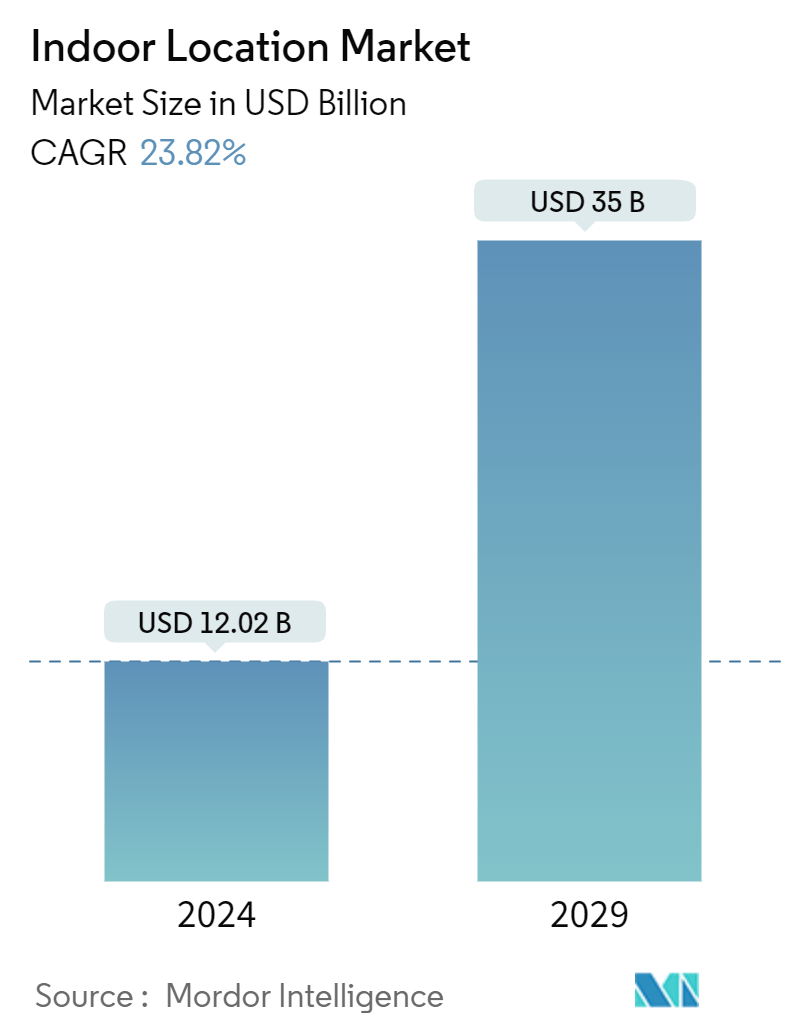Market Size of Indoor Location Industry

| Study Period | 2019 - 2029 |
| Market Size (2024) | USD 12.02 Billion |
| Market Size (2029) | USD 35 Billion |
| CAGR (2024 - 2029) | 23.82 % |
| Fastest Growing Market | Asia Pacific |
| Largest Market | North America |
Major Players
*Disclaimer: Major Players sorted in no particular order |
Indoor Location Market Analysis
The Indoor Location Market size is estimated at USD 12.02 billion in 2024, and is expected to reach USD 35 billion by 2029, growing at a CAGR of 23.82% during the forecast period (2024-2029).
- Indoor positioning systems (IPS) are stepping in where traditional GPS falls short, especially in complex environments like multistory buildings, airports, and underground parking lots. These systems, comprising a network of devices, are proving crucial in pinpointing people or objects.
- Businesses, irrespective of their size, are increasingly turning to indoor location systems for enhanced precision. These systems not only aid in precise tracking but also assist production facilities in optimizing their floor space. The surge in applications leveraging beacons, Bluetooth BLE tags, and even integrating with camera equipment, point-of-sale (POS) systems, and digital signage is propelling the indoor location market's growth.
- Businesses are swiftly adopting cloud computing and IoT for streamlined operations, with the healthcare sector leading the charge. The sector is poised for substantial growth as healthcare IoT applications align more closely with medical needs.
- Furthermore, the market for indoor spaces is expected to expand, driven by the rising demand for smartphones with advanced applications, the push for digitalization, and ongoing technology enhancements.
- However, challenges loom. Incompatibilities among infrastructures, interoperability issues, and concerns over data security are casting shadows on end users. Additionally, maintenance challenges could impede market growth.
Indoor Location Industry Segmentation
An indoor location is a system that locates people or objects inside a building with the help of acoustic signals, magnetic fields, radio waves, and other sensory information obtained through mobile devices. Indoor location tracks anything present indoors and is also recognized as indoor localization.
The indoor location market is segmented by component (solutions and services), application (indoor navigationand and maps, tracking and tracing application, remote monitoring and emergency management, and other applications), end-user industry (retail, transportation and logistics, healthcare, telecom, oil and gas and mining, government and public sector, manufacturing, and other end-user industries), and geography (North America, Europe, Asia Pacific, Latin America, Middle East and Africa). The market sizes and forecasts are provided in terms of value (USD) for all the above segments.
| By Component | |
| Solutions | |
| Services |
| By Application | |
| Indoor Navigation & Maps | |
| Tracking and Tracing Application | |
| Remote Monitoring and Emergency Management | |
| Other Applications |
| By End-user Industry | |
| Retail | |
| Transportation and Logistics | |
| Healthcare | |
| Telecom | |
| Oil and Gas and Mining | |
| Government and Public Sector | |
| Manufacturing | |
| Other End-user Industries |
| By Geography*** | |
| North America | |
| Europe | |
| Asia | |
| Australia and New Zealand | |
| Latin America | |
| Middle East and Africa |
Indoor Location Market Size Summary
The indoor location market is experiencing significant growth, driven by the increasing adoption of indoor positioning systems (IPS) that offer precise tracking capabilities in complex environments where traditional GPS is ineffective. These systems are becoming essential for businesses of all sizes, helping to optimize space and enhance operational efficiency. The integration of technologies such as beacons, Bluetooth BLE tags, and digital signage is further propelling market expansion. The healthcare sector, in particular, is at the forefront of this growth, leveraging IoT and cloud computing to streamline operations and meet medical needs. Despite the promising growth trajectory, challenges such as infrastructure incompatibilities, interoperability issues, and data security concerns pose potential obstacles to market advancement.
North America is poised to hold a significant share of the indoor location market, fueled by the proliferation of smartphones and advancements in IoT technologies. The region's strong presence in the mobile industry and its transition towards 5G services are expected to bolster market growth. Retailers in North America are increasingly adopting indoor location technology to enhance customer experiences and improve product navigation. The market is characterized by fragmentation due to ongoing research and technological advancements, with companies employing various strategies to expand their customer base. Recent developments, such as partnerships and product launches, highlight the industry's commitment to leveraging location insights for improved process efficiency and safety.
Indoor Location Market Size - Table of Contents
-
1. MARKET INSIGHTS
-
1.1 Market Overview
-
1.2 Industry Value Chain Analysis
-
1.3 Industry Attractiveness - Porter's Five Forces Analysis
-
1.3.1 Threat of New Entrants
-
1.3.2 Bargaining Power of Buyers/Consumers
-
1.3.3 Bargaining Power of Suppliers
-
1.3.4 Threat of Substitute Products
-
1.3.5 Intensity of Competitive Rivalry
-
-
1.4 Analysis on the impact of COVID-19 on the Indoor Location Market
-
-
2. MARKET SEGMENTATION
-
2.1 By Component
-
2.1.1 Solutions
-
2.1.2 Services
-
-
2.2 By Application
-
2.2.1 Indoor Navigation & Maps
-
2.2.2 Tracking and Tracing Application
-
2.2.3 Remote Monitoring and Emergency Management
-
2.2.4 Other Applications
-
-
2.3 By End-user Industry
-
2.3.1 Retail
-
2.3.2 Transportation and Logistics
-
2.3.3 Healthcare
-
2.3.4 Telecom
-
2.3.5 Oil and Gas and Mining
-
2.3.6 Government and Public Sector
-
2.3.7 Manufacturing
-
2.3.8 Other End-user Industries
-
-
2.4 By Geography***
-
2.4.1 North America
-
2.4.2 Europe
-
2.4.3 Asia
-
2.4.4 Australia and New Zealand
-
2.4.5 Latin America
-
2.4.6 Middle East and Africa
-
-
Indoor Location Market Size FAQs
How big is the Indoor Location Market?
The Indoor Location Market size is expected to reach USD 12.02 billion in 2024 and grow at a CAGR of 23.82% to reach USD 35 billion by 2029.
What is the current Indoor Location Market size?
In 2024, the Indoor Location Market size is expected to reach USD 12.02 billion.

